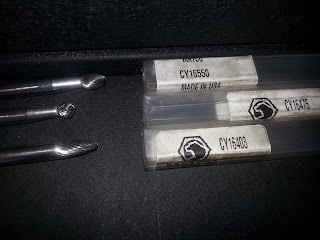What we have here is pictures of locally available motor mounts. I see that the 3 speed transmission (left picture) has a different motor mount than my 4 speed transmission. Then the center is the motor or transmission mount, which I should refer to to being over my transmission on the driver's side of the engine bay. I should inspect this one more closely for cracks or weakness.
The transmission mount on the right of the picture above is for manual transmissions.
On to the next set of mounts available for my car, and I'll get to my point:
On the left is the front motor mount (common name), but it literally is connected to my transmission. That is the correct one for either the 3 speed or 4 speed transmission like I have. The point is that the motor mount on the right is for the manual transmission. That's what I just pulled out of my 4 speed transmission car! I'm sure they bolt up the same or I wouldn't have been able to have the "wrong" one in, but now I'm relieved as it's broken that I'm getting the correct transmission mount installed.
The 2nd from the left motor mount is the only "true" motor mount on my Chevy Prizm. It's on the passenger side (in left hand drive cars) on the top/side of the engine.
2nd from the right is the motor mount (sorry, strong habit, it's literally a transmission mount), which I first noticed failed on my car. I've gotten a quality one from Toyota. Boy that was hard to get! Every sub part of that part is super high quality! Great steel, at least for how it looks and feels. Great rubber! Super good...then I looked closer at the welds. Those steel welds have something to be desired for strength, see my YouTube video below, "My New Motor Mount, long awaited, crappy welds!"
The locally available motor mounts have good welds at the moment, but the rubber is poor and I expect failure like before so I want to window weld them with 60 shore strength. Once drag racer of a Hyundai Elantra on the Jafromobile YouTube channel uses 80 shore strength, but seeing as how I can't find that and he has literally 4 times the acceleration that I have in my Chevy Prizm, I think 60 shore strength is plenty strong to plus up this lower quality locally obtainable part.
Sure, you may say, just get another one from Toyota (a Chevy Prizm is basically a Toyota Corolla), but that took a month, I'm not going 2 months without my car. The rear transmission mount is what is hours of work to get to the, the front one can be removed with much less subframe disassembly.
I'm working literally on uploading a video to show the Toyota, USA made motor or rather transmission mount as you read. :)
Here's my uninstallation of the front and rear motor mounts:
The next video I'm in the process of editing is a motor mount inspection video and half of the installation. What are different problems they can have? Failed welds, sure, most commonly the rubber gets cracks. Some cracking with age can be okay if the engine still is held firmly in place when you brake torque the engine. That's where you put the car in drive or reverse, hold the brake, and press the gas some. The engine should move some, but mine was flopping like a fish!
Motor Mounts Front & Back Installation Part 2:
Source: Motor Mounts Front & Back Installation Part 2 of 3 by DENichols
Motor Mounts Front and Back Installation part 3 Finishing End links mostly:
I'm embedding the part 2 video in my article when I last brought up replacing at least one of the same motor mounts! Shocks, Struts and the Steadiness of Your Car or Truck














